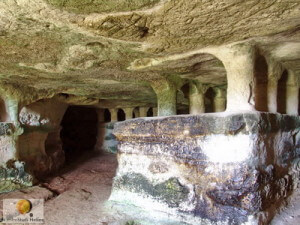Trabacche cave
The Trabacche Cave is located in Contrada Buttino about 5 km from Ragusa; to reach it you can take as a reference the intersection between Via Archimede, Via San Luigi, Via Mongibello and Via Fanfulla from Lodi (on the outskirts of Ragusa). Head along Via Fanfulla from Lodi, at the roundabout continue along Via Colleoni, from where the so-called Strada dei Cento Pozzi begins (as it leads to the famous Contrada dei Cento Pozzi.). Exactly 1,6 km from the beginning of Via Colleoni, the provincial road Beddio-Tresauro-Piombo (SP.13) begins which from Ragusa reaches the ancient Kamarina. At Km 3,2 of the SP.13 turn left onto a slightly downhill road, which after about 100 meters becomes a dirt road, continuing along this road, after a few hundred metres, observing the ridge on the right, you can glimpse two caves, the the second of these, the largest, is the Trabacche cave. The Contrada Buttino is contiguous to the Contrada Cento Pozzi, so much so that the two localities are often considered a single district with the name Buttino – Cento Pozzi. Various testimonies, including some necropolises which present open-air tombs (sub divo) of Hellenistic type, would suggest that the places were inhabited at least since the Hellenistic period. The discovery of a necklace from the 150rd century AD, 1 cm long made up of segments of gold thread with hooked ends and preserved in the Archaeological Museum of Ragusa[XNUMX], would confirm the human presence in Roman times. The Trabacche Cave is probably from the Roman or late Roman era and was certainly used as a burial place in the Byzantine era, when there was a Byzantine village in the area. The name of the cave probably derives from the similarity that the two sepulchral monuments in the center of the cave have with the ancient canopy-shaped beds, part of which was indicated with the term "Trabacca". A popular legend would have it that the name derives from the fact that three cows entered the cave and were unable to get out. The Grotta delle Trabacche represents a significant testimony of monumental funerary architecture, what characterizes it is the presence of two canopy tombs (also called a tegurium). The cave was described and designed by Jean Hoüel, traveler and artist in the era of the "GrandTour"[2], author of the four volumes of the "Voyage Pittoresque del isles de Sicile, de Malte et de Lipari" published between 1782 and 1787 The cave, preceded by a rectangular entrance compartment, has a square plan and measures approximately 380 square metres. The height is approximately 2,50 metres, along the side walls there are arcosolia[3] polysomes (i.e. with multiple niches contained in a single pit). On the floor there are numerous niches, some of which are now buried. But what most characterizes the catacomb are the two canopy tombs, made from two large rectangular blocks of rock that join the floor to the ceiling and which measure 3,50 m in length and approximately 2,50 m in width. The first sepulchral monument has seven pillars, 4 on one side and three on the other (a fourth was destroyed). Each pillar is approximately 80 centimeters high characterized by rough capitals that join with the ceiling. The second oneTegurium it has nine pillars: four on each side plus one in the center on the side facing the entrance to the cave. In the bases of each of the two funerary structures there is a large burial niche about m. 2,50, wide m. 1,75 and about 1 meter deep. Caves of this type are widespread in Sicily, at times they are known simply as "hypogea" [4], at other times the term "catacombs" is used to underline their use as a Christian cemetery. To tell the truth, the absence of Christian symbols in a cave used as a burial place, could not exclude that this cave was a pagan burial place, in which case the term catacombs could be improper. Other hypogea in the Ragusa area:
- Grotta Marini, not far from the Trabacche cave;
- Catacomb of Contrada Celone (Ragusa);
- Hypogeum of the district of Cisternazzi (Ragusa)
- Catacombs of S. Marco (Ispica);
- The "Ladreria" Cava Ispica Nord;
- Catacombs of Contrada Treppiedi (Modica);
- Catacombs of Porcara quarry (Comiso)
- Cava Martorina (Ispica);
- Contrada Albarcàra (Ispica);
- The "Camposanto" of Cava Ispica
- Catacomb of Grasullo (S. Croce Camerina)
- Catacombs of Recucco (Camarina)
- Hypogeum of Pirrera (Caucana)
- Acrillae (Chiaramonte Gulfi)
[1] Giovanni Di Stefano: The Archaeological Museum of Ragusa. Electa Naples 2001 pag. 84 [2] An almost obligatory stage in the training course of the nobles and young people belonging to the European aristocracy. [3] The term arcosolium generally means a sepulcher formed by a niche carved into the wall and having a funerary ark or sarcophagus at the base. This type of burial was widely used in the Christian catacombs. [4] local, underground room dug into the rock used as a burial, a place of worship, or with primitive peoples as a dwelling
Site subject to archaeological constraint (?)




